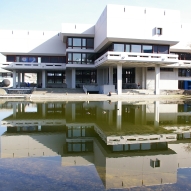 ; Meneghini, Maria
; Meneghini, Maria  ; Crespo, Elena ; Bemelman, Frederike ; Koch, Martina ; Volk, Hans D. ; Viklicky, Ondrej
; Crespo, Elena ; Bemelman, Frederike ; Koch, Martina ; Volk, Hans D. ; Viklicky, Ondrej  ; Giral, Magali ; Banas, Bernhard
; Giral, Magali ; Banas, Bernhard  ; Ruiz, Juan C. ; Melilli, Edoardo ; Hu, Liu ; van Duivenvoorden, Raphael ; Nashan, Björn
; Ruiz, Juan C. ; Melilli, Edoardo ; Hu, Liu ; van Duivenvoorden, Raphael ; Nashan, Björn  ; Thaiss, Friedrich ; Otto, Natalie M. ; Bold, Gantuja ; Stein, Maik
; Thaiss, Friedrich ; Otto, Natalie M. ; Bold, Gantuja ; Stein, Maik  ; Sefrin, Anett ; Lachmann, Nils ; Hruba, Petra ; Stranavova, Lucia ; Brouard, Sophie ; Braudeau, Cécile ; Blancho, Gilles ; Banas, Miriam
; Sefrin, Anett ; Lachmann, Nils ; Hruba, Petra ; Stranavova, Lucia ; Brouard, Sophie ; Braudeau, Cécile ; Blancho, Gilles ; Banas, Miriam  ; Irure, Juan ; Christakoudi, Sophia ; Sanchez-Fueyo, Alberto
; Irure, Juan ; Christakoudi, Sophia ; Sanchez-Fueyo, Alberto  ; Wood, Kathryn J. ; Reinke, Petra ; Grinyó, Josep M.
; Wood, Kathryn J. ; Reinke, Petra ; Grinyó, Josep M. | Dokumentenart: | Artikel | ||||
|---|---|---|---|---|---|
| Titel eines Journals oder einer Zeitschrift: | American Journal of Transplantation | ||||
| Verlag: | WILEY | ||||
| Ort der Veröffentlichung: | HOBOKEN | ||||
| Band: | 21 | ||||
| Nummer des Zeitschriftenheftes oder des Kapitels: | 8 | ||||
| Seitenbereich: | S. 2833-2845 | ||||
| Datum: | 2021 | ||||
| Institutionen: | Medizin > Abteilung für Nephrologie | ||||
| Identifikationsnummer: |
| ||||
| Stichwörter / Keywords: | ; biomarker; clinical decision-making; clinical research/practice; clinical trial; immunobiology; immunosuppression/immune modulation; immunosuppressive regimens - minimization/withdrawal; kidney transplantation/nephrology; rejection: acute | ||||
| Dewey-Dezimal-Klassifikation: | 600 Technik, Medizin, angewandte Wissenschaften > 610 Medizin | ||||
| Status: | Veröffentlicht | ||||
| Begutachtet: | Ja, diese Version wurde begutachtet | ||||
| An der Universität Regensburg entstanden: | Ja | ||||
| Dokumenten-ID: | 56694 |
 Web of Science
Web of ScienceZusammenfassung
Personalizing immunosuppression is a major objective in transplantation. Transplant recipients are heterogeneous regarding their immunological memory and primary alloimmune susceptibility. This biomarker-guided trial investigated whether in low immunological-risk kidney transplants without pretransplant DSA and donor-specific T cells assessed by a standardized IFN-gamma ELISPOT, low ...

Zusammenfassung
Personalizing immunosuppression is a major objective in transplantation. Transplant recipients are heterogeneous regarding their immunological memory and primary alloimmune susceptibility. This biomarker-guided trial investigated whether in low immunological-risk kidney transplants without pretransplant DSA and donor-specific T cells assessed by a standardized IFN-gamma ELISPOT, low immunosuppression (LI) with tacrolimus monotherapy would be non-inferior regarding 6-month BPAR than tacrolimus-based standard of care (SOC). Due to low recruitment rates, the trial was terminated when 167 patients were enrolled. ELISPOT negatives (E-) were randomized to LI (n = 48) or SOC (n = 53), E+ received the same SOC. Six- and 12-month BPAR rates were higher among LI than SOC/E- (4/35 [13%] vs. 1/43 [2%], p = .15 and 12/48 [25%] vs. 6/53 [11.3%], p = .073, respectively). E+ patients showed similarly high BPAR rates than LI at 6 and 12 months (12/55 [22%] and 13/66 [20%], respectively). These differences were stronger in per-protocol analyses. Post-hoc analysis revealed that poor class-II eplet matching, especially DQ, discriminated E- patients, notably E-/LI, developing BPAR (4/28 [14%] low risk vs. 8/20 [40%] high risk, p = .043). Eplet mismatch also predicted anti-class-I (p = .05) and anti-DQ (p < .001) de novo DSA. Adverse events were similar, but E-/LI developed fewer viral infections, particularly polyoma-virus-associated nephropathy (p = .021). Preformed T cell alloreactivity and HLA eplet mismatch assessment may refine current baseline immune-risk stratification and guide immunosuppression decision-making in kidney transplantation.
Metadaten zuletzt geändert: 29 Feb 2024 12:36



 Altmetric
Altmetric